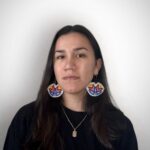From stories to stitches, beadwork reflects history and community
Stories we loved to tell: Reimagined beadwork possibilities and storytelling at the ‘Radical Stitch’ exhibit
Taqralik Partridge, originally from Kuujjuaq, stands beside her contributed works to the Radical Stitch exhibit that was on display at the National Gallery of Canada in Ottawa. (Photo by Kierstin Williams)
Beadwork is more than an art form, it’s a way of telling important stories of the past, present and future while sharing the knowledge of where we come from.
In May, I went to the National Gallery of Canada in downtown Ottawa ahead of the grand opening of the travelling exhibit Radical Stitch, which featured more than 100 works by 44 Inuit, First Nations and Métis artists from across Canada and the United States.
Countless hours of planning, gathering the right materials and colours, and then beading go into creating the luxury work that often reflects parts of the artist, tells stories of their family history, and the style of their community.
As a beader myself, it was a dream to visit the largest contemporary beadwork exhibition and to speak with renowned multidisciplinary artist and curator Taqralik Partridge about her work on display.
Partridge, who is from Kuujjuaq, created Apirsait in 2020, a series of mixed-media glass beadwork panels that featured Arctic creatures like caribou, walrus and Arctic fox.
While standing next to her work, I asked her about the inspiration behind her contribution and the story it tells.
Partridge spoke about how her beadwork embodied a story her father told her of how, during a time of Inuit starvation, he felt that the walrus was his spirit helper.
During the starvation, someone brought him walrus meat that helped save his life.
“I think it’s a representation of a spirit, or various groups that come and help you in times of need,” Partridge told me.
While exchanging ideas about beadwork techniques and tricks, Partridge explained that while in Norway, she worked at her kitchen table — a familiar setting for most who do beadwork.
She used glass beads, sewing scraps, dental floss, a dish cloth and the plastic from the packing of chicken nuggets.
While I hadn’t thought of the innovative use of the plastic from a chicken nugget package before, I told Partridge how I’ve used the lid from a Pringles can to help flatten and reinforce flat stitched earrings.
“The idea of being into the environment, I think for me, is also about using stuff that’s around, not just buying stuff that is so-called green,” she said. “Or using what we already have and is making a mess.”
Wide-eyed and slowly walking through the Radical Stitch exhibit, I tried to take in as much of the beauty and talent on display as possible, in awe of how the various works redefined what I thought was possible for beadwork.
Partridge’s work is also part of another exhibition at the National Gallery of Canada until April 2025, as she was a finalist for the 2024 Sobey Art Award, a national prize that recognizes contemporary visual arts.
She represented the circumpolar region, which included artists from Yukon, Northwest Territories, Nunavut, Nunavik and Nunatsiavut.
Nico Williams, a member of Aamjiwnaang First Nation, also had works featured in the Radical Stitch exhibit and took home the top prize of $100,00 for the award in November.
I was fortunate to cover Partridge’s work and view the incredible exhibit with beadwork telling the stories from many Indigenous communities.
The distinct styles of each artist, their stories, and communities were reflected in the artwork and inspired me to transcend my idea of what was possible with beadwork.
That’s why the Radical Stitch exhibit was the story I most loved to tell in 2024.







My son now 29 is bone sauniq namesake with Jacob Partridge, a mild mannered man as I remember him.